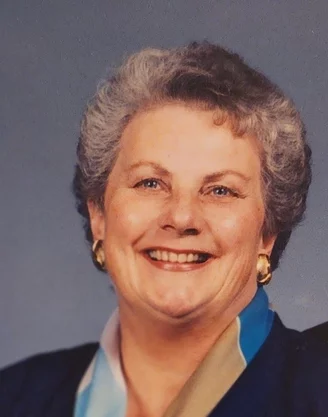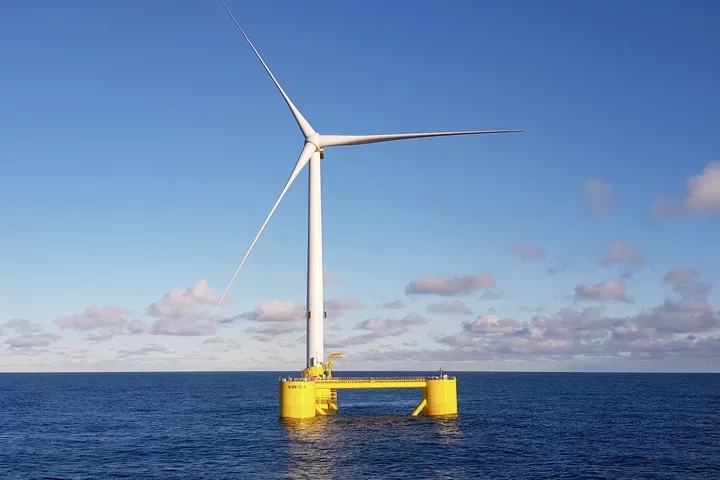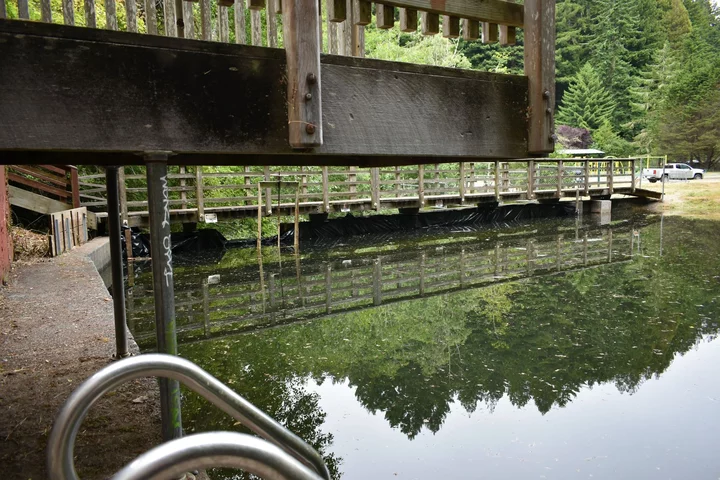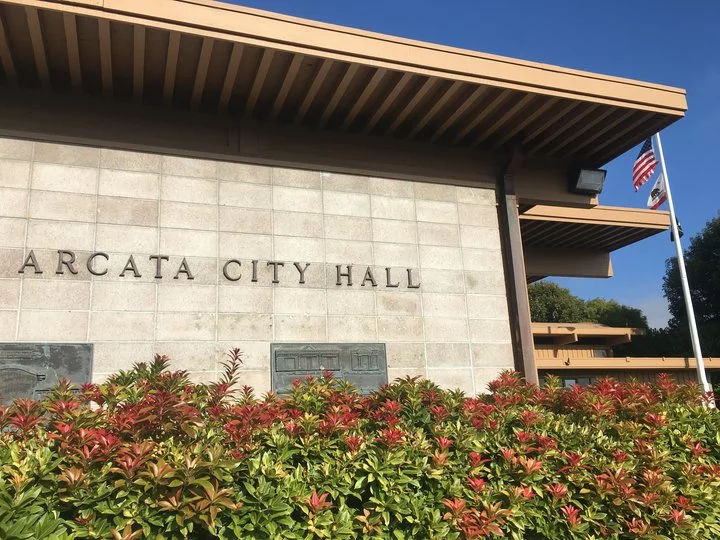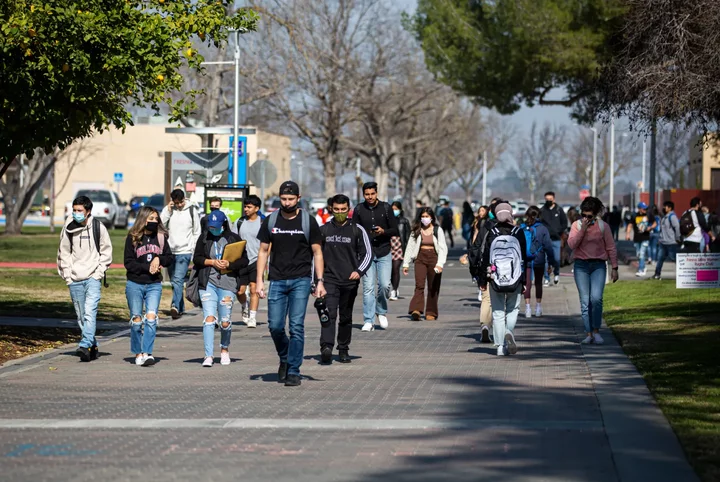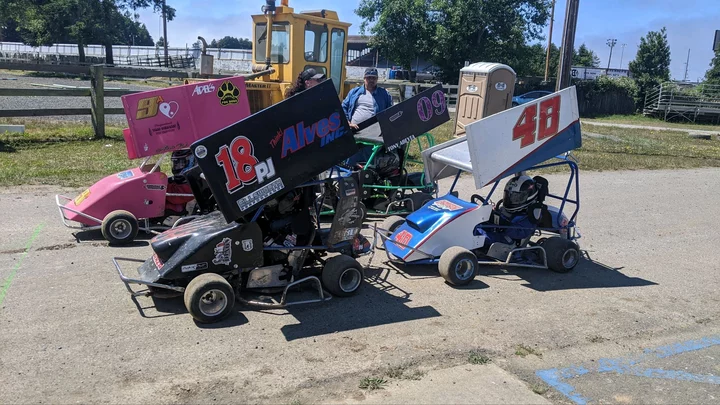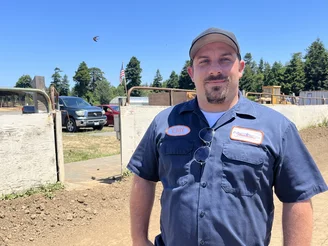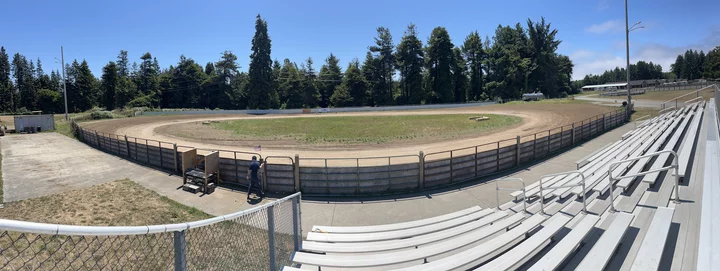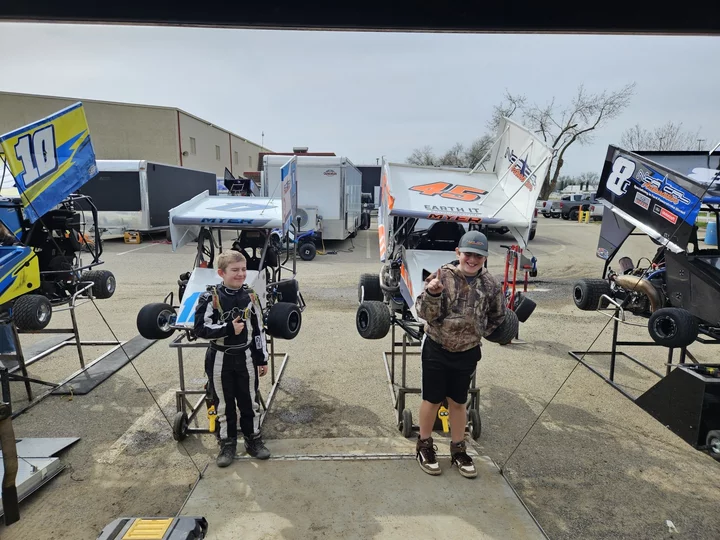OBITUARY: Martha Howard, 1938-2023
LoCO Staff / Saturday, July 1, 2023 @ 6:56 a.m. / Obits
Martha Howard, a 60-year resident of Fortuna, was born in January
of 1938, in Queens, New York. She went home to her Lord on June 5,
2023, after a serious heart condition. Martha spent her early years
in St. Lewis, Mo. until her family moved to Long Beach, where her
father, a skilled tool and die maker, worked in the Long Beach Naval
shipyard during WWII. She remained there until her marriage. She was
very active in her church youth group and participated in many short
trips with the group. In 1958, she met the love of her life in the
carpool she took to work. Charles and Martha were united in marriage
in 1959. The young couple had two children, Janice Howard-Martin, and
Charles Howard, II.
Martha was a joyful person and loved to have laughter and fun in her life. She worked part-time while her children were in their teens and dedicated the rest of her time to their pastimes. She planned fun activities for her family including summer dinner Picnics and swimming at Women’s Federated Grove (Four Fireplaces), camping at various state parks, and vacations throughout the western United States. In the couple’s retirement, they were able to travel to England to visit their son stationed there. She also enjoyed laughing and joking with her three treasured granddaughters.
She remained a devoted member of Christ Lutheran Church until her death. She served as a council member and enjoyed the Women’s group activities including sewing needed items for St. Luke’s Convalescent Home and making warm quilts for those in need. She loved knitting and her hands were constantly busy making socks and hats for the homeless. After working at College of the Redwoods, she decided to attend the college and continue her education. She graduated in 1982 from College of the Redwoods, with an Associate of Arts degree in business.
She was preceded in death by her husband, Charles Howard, to whom she provided devoted care during his long illness with Alzheimer’s Disease; her parents Carl and Hilda; her brother and best childhood pal, Carl Edward; her sister in-law Kathy; and her brother in-laws, Wilbur Branch and James Howard. Her sister, Camille Branch, passed away two weeks after Martha.
Martha is survived by and will be missed by her younger brother John, and her children Janice Howard-Martin and Charles Howard, II. She will also be dearly missed by her three granddaughters Rebecca, Emily, and Rhiyon. She leaves behind her sisters and brothers by marriage who loved her as their own, as well as numerous nieces, nephews, her goddaughter and many dear family and friends.
A memorial service will be held on Saturday, July 8, 2023, at 11 a.m., at Christ Lutheran Church, 2132 Smith Lane, Fortuna, Pastor Paul Demant officiating. There will be a celebration of life at the church’s social hall following the service. Private interment beside her husband will be at Sunrise Cemetery, Fortuna. Cremation provided by Ayres Family Cremation, Eureka.
In lieu of flowers, donations can be made in Martha’s name to Christ Lutheran Church, 2132 Smith Lane, Fortuna, CA 95540.
###
The obituary above was submitted on behalf of Martha Howard’s loved ones. The Lost Coast Outpost runs obituaries of Humboldt County residents at no charge. See guidelines here. Email news@lostcoastoutpost.com.
BOOKED
Yesterday: 7 felonies, 15 misdemeanors, 0 infractions
JUDGED
Humboldt County Superior Court Calendar: Today
CHP REPORTS
3rd St / L St (HM office): Roadway Flooding
Mm199 N Dn R22.00 (HM office): Traffic Hazard
2700 Mm199 S Dn 27.00 (HM office): Traffic Hazard
ELSEWHERE
RHBB: Cal Fire Lifts Burn Suspension in Mendocino County
Growing Pains, with Nick Flores: #230 - U.S.-China Tensions: Trade, Power, and Global Futures with Scott Kennedy
Politico: Johnson says he had ‘thoughtful’ conversation with MTG about bucking Republicans on healthcare
Governor’s Office: Governor Newsom signs bill to protect parents’ rights and children
LoCO Interview: The Outpost Talks to Vineyard Offshore, One of the Developers Working to Bring Floating Offshore Wind Energy to the Humboldt County Coast
Isabella Vanderheiden / Friday, June 30, 2023 @ 4:47 p.m. / Energy , Offshore Wind
A 9.5-megawatt floating wind turbine deployed at the Kincardine Offshore Wind project, located off the coast of Aberdeen, Scotland. Photo: Principle Power.
###
A few of the folks representing Vineyard Offshore stopped by the Outpost office this week to talk about offshore wind development on the North Coast and what that means for the people of Humboldt County.
Vineyard Offshore is a North America-based developer for Copenhagen Infrastructure Partners, one of the energy companies that was awarded a lease to develop floating offshore wind energy facilities on the West Coast during a lease auction hosted by the Bureau of Ocean Energy Management (BOEM) last December. Copenhagen Infrastructure Partners and RWE Offshore Wind Holdings, LLC placed the winning bids for two lease areas in the Humboldt Wind Energy Area (WEA), which spans more than 132,000 acres approximately 20 miles west of Eureka.
The Vineyard Offshore team is currently working on Vineyard Wind 1, the nation’s first utility-scale offshore wind energy project, located about 35 miles off the coast of mainland Massachusettes.
In our interview, Jennifer Cullen, the company’s director of Labor Relations and Workforce Development, talks about the job creation aspect of the project and her hopes to employ local folks in long-term positions at the future wind farm. Erik Peckar, who recently took on the title of West Coast Director of External Affairs, tells us about his experience in working with coastal communities on developing strong Community Benefits Agreements. Andrew Doba, the director of communications, chimes in here and there.
Our conversation has been edited for length and clarity.
###
LoCO: What brings you to Humboldt County this week?
Jennifer Cullen: Well, we just left a conference with LIUNA, the Laborers’ International Union of North America. They convened a group of 60 or 70 people, including contractors and community partners, as well as the two developers that both have lease areas off the Humboldt County coast – Vineyard Offshore and RWE [Offshore Wind] – to talk with the community about workforce development and, specifically, engagement with the labor unions. I spoke about our workforce development and our project labor agreement for our project on the East Coast. …
We know the communities where we’re from and we’re here to get to know Humboldt better. There are a lot of stakeholders here that are very engaged and really interested in [offshore wind] but there’s still a question surrounding, you know, “What does this mean for us? How does this work? Who are you guys? What are you doing?” We’re just doing our best to try to get to know all of the various community partners we’re going to be working with.
Erik Peckar: Well, this is my third day on the job as the West Coast Director of External Affairs [for Vineyard Offshore]. I actually came out to California five or six weeks ago to talk to some folks about the Community Benefits Agreement (CBA) and my experience in working with Vineyard Power, which is a non-profit on the island of Martha’s Vineyard. … Humboldt is really at the beginning level. This is a big opportunity for me to really take a lot of the lessons learned with Vineyard Power and translate a lot of those skills in the development space to what’s kind of going on here.
I’ve been involved in the community organization space on Martha’s Vineyard since 2010. I think a big part of this is bringing the community along, and understanding that the community has some ownership of the project and has a voice in the project. We want to foster a true partnership with these CBAs between developers and communities to make sure everyone is walking hand in hand. There are a lot of things that the community will want from these projects and you can’t attain those goals without the project actually succeeding. It’s kind of a two-way street in terms of getting things done. So, we’re doing a lot of listening, a lot of learning, a lot of just meeting folks and really trying to understand the needs of the community.
LoCO: I have had a hard time trying to understand exactly what the process is for the CBA money. I understand that this money was pledged upon the purchase of the leases but how is the pledge fulfilled and what are the mechanics for that? This is something the community is very interested in and it’s kind of the tip of the iceberg for what we are hoping this sort of new industry will bring into the community, but I think people are confused – I’m certainly confused – about how the whole process works.
Peckar: The process here in California is a little bit different from my experience in Massachusetts in terms of the timing of things. In Massachusetts, we had [our CBA] prior to the lease auction. Rewind back to 2015 or 2016. We, as a community, got [BOEM] to recognize CBAs as a discount factor in the auctions. So they would give a certain percentage credit to a developer that had CBA with a community benefit organization. Vineyard Power essentially got the support of all of the six towns on Martha’s Vineyard to come together and we were kind of, you know, dubbed the community benefit organization to be able to negotiate with a developer on behalf of the community.
LoCO: So, Vineyard Power was the community benefit organization?
Peckar: Correct. And the main tenants of what we wanted for the community was, initially, we wanted some sort of option to potentially purchase the electricity. We were looking at jobs – operations and maintenance jobs specifically. The project committed to having an operations and maintenance facility on the [island] because, once construction is completed after two or three years, you then move on to the operation phase and the construction jobs phase out. So, there are jobs that the project developers committed to being on Martha’s Vineyard for the lifetime of the project.
Another thing is all of the six towns on Martha’s Vineyard came together to commit to being 100 percent renewable and convert our transportation electricity by 2040. … Where do we get their electricity from? We get it from offshore wind. That was kind of the magic space that we as a community wanted to get to and the project developers committed a certain portion of the funding to help us reach those goals. … They understood that partnering with a community benefit organization and having the community on your side would increase the likelihood that the project was going to succeed. That has played through to fruition with construction going on right now and with the project being awarded the first power purchase agreement in Massachusetts.
Andrew Doba: And you’ve got to remember, this is all in the shadow of Cape Wind, which was a project that was going to be closer to shore in Nantucket Sound and was basically debated for 16 or 17 years before it was finally shut down. There were a lot of lessons learned from that failed process. We wanted to make sure the next project was built from the ground up rather than saying, “Top-down, this is what we’re trying to do.”
Cullen: My hometown is where Cape Wind was our cable for this project and where Cape Wind’s cable was proposing to make landfall. My town sued the federal government when they granted the permit. … So, when this project came around we understood that you don’t shove a project like this into a community; you build it with the community. We had a really good working relationship throughout the process where Vineyard Power understood the project and could provide really useful input about the design of the project as well as community concerns so nothing would come as a surprise when we would do our permitting public hearings. … We knew the concerns and we also had already incorporated that input into our design. …
One of the things people on the island really wanted were those long-term jobs. It was a tough commitment for us to make because there’s only one place that you can build a facility like that on the island because of zoning … but now, the facility is under construction and our commitment is that 100 percent of those workers will be island-based within five years. You don’t relocate people to an island like Martha’s Vineyard. You find, recruit and train the locals to do those jobs because housing is nonexistent. … But I can’t just bring the jobs to a place that says “We want jobs!” if there aren’t the right people to fill those jobs. We needed to find people and figure out what they would need to go from a bartender or a landscaper… to a qualified offshore wind technician. So, we worked with the community in setting up a community college program that was available locally on the island.
LoCO: Are you working or partnering with College of the Redwoods or Cal Poly Humboldt to create similar programs here?
Cullen: It’s still really early in the game but I know both educational institutions have been thinking about [developing those programs] way before we got here. … College of the Redwoods especially because a lot of our jobs – I would say 90 percent – are more technical and don’t require a four-year degree. … I’m going to work on getting them just information about the certifications that we’ve needed and that we’ve seen our suppliers need. And then Cal Poly Humboldt, College of the Redwoods and the Yurok Tribe all have an MOU [memorandum of understanding] to collaborate but it doesn’t sound like there’s a whole lot of detail to it just yet. …
Peckar: Partnerships with universities are absolutely critical … in facilitating in training, workforce development [and] communications, but also in reaching the whole community and ensuring that women and [BIPOC] Black, Indigenous, people of color are also getting the same opportunities as middle-aged white guys. That’s really important. …
LoCO: Going back to the CBA, we still need a certified community benefits organizer, right? We don’t have a place in Humboldt County where these investment funds will be deposited and we don’t know yet how they will be spent. How will that process work here?
Cullen: I mean, there’s basically no roadmap for any of this kind of stuff. So many of the commitments we’ve made and have now executed with Vineyard Wind were written down as a bid or a little project and we submitted it and then suddenly it’s like, “Now make this stuff real. Make it happen. Put people on jobs. Do the [CBA].” As for how it will work here, there aren’t really answers to a lot of those questions.
LoCO: But, at some point, BOEM will have to decide or identify an entity to receive those CBA funds, right?
Peckar: That’s all written out in the Final Sales Notice. … Now there’s a clock, let’s say, and the two developers up here and the three developers down in Morro Bay need to go into these communities and find or meet folks who represent the community and sign these CBAs or come to some arrangements by a certain particular time.
Cullen: And the challenge we have is understanding who that is, right? There might be some people that say, “We represent the community and we know what’s best.” I mean, we just won this lease in December but our teams have already been out here four or five times at this point because we need to get this right. We need to know that the entity or entities that say they represent the community actually do have the tribes, the fishermen, the laborers and all of these partners legitimately involved so they can say, “Yes, this is the entity that will speak on behalf of my community.”
Peckar: The community really needs to understand that this is a partnership. We’re not just going to cut a check and go away. Once the permitting phase starts and we go into a process with the federal government where there are public hearings, we as a company need folks to show up and show their support. …
There are going to be pieces of this project that will require valuable input that are not part of the CBA. One example from the project on the East Coast is, you know, we as a community were really concerned about nighttime lighting from the project. … And the feedback we gave into the project was basically asking if there were technical components they could potentially mitigate. You know, instead of having all 62 turbine lights being on every night all night, what are some options there? They looked into it and it ultimately got approved to use an aircraft detection lighting system. … Those lights will only come on when an airplane flies within a certain level of the turbines. …
This is an iterative process and there are options on the table. We want to work with the community, but there’s also the question of whether it is technically feasible to do certain things. …
LoCO: I understand that building this kind of relationship with the community is really what you’re striving for … and the CBA is a small part of that, but one of the concerns I hear a lot surrounds infrastructure and the housing crisis. Hopefully, we could use some of that for matching funds to build new housing to accommodate the workforce we’re anticipating here. … We want to be sure that we are able to accommodate the growth that goes along with that, but there’s concern that instead of going through some sort of public process … it would end up in, say, the arms of a nonprofit without a public process.
Peckar: Again, going back to the CBA process that we went through with communities on Martha’s Vineyard, you know, there are six towns on the island. One town says one thing and one town wants to do the exact opposite. It was an educational process. We knew that we would never achieve what we wanted to achieve if one town tried to come out and organize independently.
Back in 2009/2010 when we could kind of see where this process was going, we just did our best to educate everyone along the way at a municipal level to get complete buy-in and build trust. We had to say, “Hey, we’re the organization that could lead us in this direction and we can negotiate on behalf of the whole island … what do we want?” … We formed an advisory committee with members representing all six of the towns, we have a tribal nation on Martha’s Vineyard as well and they are represented. Then there are some nonprofits and others that sit on the steering committee. However, I can’t sit here and say that model will work for you. This community really needs to sit down and have some discussions about the local needs and who they want to negotiate for them, and that’s challenging.
Cullen: Where we have been the most successful in our community partnerships … is when we’ve been involved in a transparent process with an entity that has the trust of the communities that we’re working with. One in which people see the opportunity, not just in the dollar sitting in the bank, but how to leverage those dollars alongside the project to maximize it all. We’re gonna be bringing in suppliers, we’re gonna be bringing in electricity, we’re gonna be bringing in all of these different things and if that money is used to address some of the barriers to maximizing the overall benefit that works for us and that works for the community.
In Massachusetts, for instance, we have wicked infrastructure issues in those small communities out on the coast and we have a huge wastewater problem. … So, we worked really closely with [one of] the town[s] because we needed permits from the town, we were gonna run cables in their streets and land or our cable at the beach. And they were like, “The sewer thing is a huge problem for us and we’ve got a plan but it’s literally a billion-dollar project.” And so we worked with them and they advanced their timeline to lay some really critical sewer backbone infrastructure in the same route that we were routing our cable. So we said, “Great, we’re gonna open the roads. You guys go ahead and go in first to lay the sewer lines and we’ll come in after, lay the cable and close the roads.” It saved the town like $10 million.
LoCO: Well, the transmission of electricity is a huge issue up here, especially in Southern Humboldt where PG&E is basically at capacity. I have heard the statewide electrical transmission system likened to a series of blood vessels. Here in Humboldt, our lines are like capillaries and we need an aorta to handle and distribute the power that will be generated by the wind turbines. Congressman Jared Huffman and other state representatives are trying to expedite these critical infrastructure improvements but, I’m curious, where do you fit into that process?
Cullen: What I’m hoping is that Lieutenant Governor [Eleni Kounalakis], who was at the labor event we attended earlier, will help further transmission goals in California. Humboldt is so critical – not just for the projects happening in the Humboldt [Wind Energy Area] but for projects up and down the coast [because] the port is going to be booming. We can’t move forward on these goals until there’s improved electrical transmission. … We can’t even really start designing or understanding how big of a project to build until we know more about capacity, who we’re selling the power to [and] what the rates are looking like. There’s so much that needs to happen before we can even start, but as soon as that’s ready we’re itching to go. …
LoCO: Are you working with lawmakers or with PG&E to try to figure out solutions to make a larger transmission line to the project area?
Doba: Some of our senior management recently met with some elected officials down in Sacramento. At this point, we’re just anxious to make sure the conversation keeps going and then ultimately [leads] to some kind of resolution.
Cullen: I mean, building an offshore wind farm is really a massive undertaking and, on top of that, there are all of these other challenges. We need partners in the state that wants this and they have to support the parts of this that are really theirs to do. … We want to make it better but oftentimes we [as developers] are expected to solve these legacy issues, clean energy, job creation, societal issues, public transportation, etc. … A lot of these things that really require all these entities to work with us to provide the bones to make it work.
LoCO: One thing we haven’t touched on yet are concerns surrounding the commercial fishing industry. I’m sure your team is well-versed on this topic having worked with coastal communities on the East Coast. … A lot of the fishermen I’ve spoken with are worried they’re going to lose access to fishing grounds. Over the years, their fishing grounds have gotten smaller and smaller due to increased regulations around commercial fishing. Can you talk about how you worked with commercial fishermen on the East Coast to alleviate some of these concerns? How will that inform your conversations here?
Cullen: [Crista Bank] is this totally badass woman who does our fisheries work and she’s very well respected in the community. It’s so key for us because she knows these guys, they trust her. They give her an earful regularly, she takes it because she knows them, and then they go get a beer, you know? One thing we heard from [the fishermen] really early on – and what we’ve been working with Crista on – is making sure they don’t miss out on an economic opportunity, too. It’s the same thing on the East Coast: the fishing grounds are shrinking but the quota isn’t.
We worked with them through the permitting process, engaging with them, listening to them, what are their concerns … and we ended up rearranging our entire turbine layout to be responsive to their concerns. … We had to start from scratch with all the survey work, but it was the right thing to do. We spaced them out a full nautical mile so you can now go any which way through it. It was really tough to do but we did it and all [six] of our lease holders in that area agreed to have the same like layout. …
We’ve also provided funds to get fishermen trained to a certain standard … and vessels that want to work on the projects, we said, “Hey, we’ve got scope and we’ve got a need for you. We appreciate and recognize your knowledge of how the sea works and we see that you’re a valuable asset in making this project successful.” … So they go out there with us and they just kind of, like, babysit our vessels and make sure that any incoming or passerby vessels are understanding what’s going on. And we’ve found that the fishermen really appreciate the work. …
Peckar: We want to get a better understanding of the fleet here in Humboldt, who the players are and who’s who. That’s what we’re getting into now, really trying to lay that foundation with some potential fishery representatives and we want to hire a fishing liaison for the West Coast. … We will also start up some surveying work in the next couple of years which might include opportunities for fishermen to go out on a survey vessel to make sure there aren’t any interactions with crab pots or help us in identifying someone else’s gear. We need people who are already a part of the fishing community that people really trust because, ultimately, this is all about building trust. …
Cullen: We only had to do a year of pre-construction surveys but we did three. We knew that understanding the impacts that we have is going to be important and so we went above and beyond on that because we knew it was gonna be critical. We kind of set the bar for the other developers and we encouraged them to do a lot of research as well so, ideally, years down the line we can say, “Yes, we built this project based on real science that you guys all bought into.” And the impact really hasn’t been what everyone was worried it would be and we can really, genuinely back that up. …
LoCO: And going back to working with other developers, what does that process look like? Are you all using the same technology? Are you working together on certain studies? Is each development going to have its own set of operating standards? In what situations do you and do you not work together?
Cullen: What’s tricky along the East Coast – and I hope it’s better for us here – is that we’re asked to compete on things [and] competing yields lesser overall results for the communities that we’re collaborating with. … We need to all come together on what the technical specs will be that we’re all working towards. Right now, I mean, how many foundation designs are there for floaters? Twenty? Thirty? Ideally, we all use the same technology. …
LoCO: Well, to wrap things up, what are the next big steps for Vineyard Offshore? Any other closing remarks?
Peckar: Well, I’m going to be moving out to the West Coast in October. I’ll be based out of the Bay Area but I’ll be coming up here pretty regularly and building a team. I’m really looking forward to getting to know the folks here and building a relationship with this community. … We want to keep the conversation going with the folks at Crowley and the port and keep working at the state level to keep things going with power purchase agreements. … It would be great to have a little cross-pollination and bring folks from the East Coast out here and vice-versa to learn more about the work we’re already doing out there and share that knowledge.
Cullen: I think continued engagement with the port and making sure we’re all aligned on what’s getting built and that it’ll support what we need. I think a lot of [this process] is just building relationships in the community. … I think the next couple of years are really going to be getting to know this place and them getting to know us. There’s a lot it’s still unknown! We’re not just being cute about it, there’s a lot about this industry that we don’t really know yet.
###
PREVIOUSLY:
- Biden Administration Proposes Offshore Wind Lease Sale, Including Two Spots Off the Humboldt County Coast
- IT’S ON: Humboldt Offshore Wind Leases to Go Up For Auction on Dec. 6
- Harbor District Announces Massive Offshore Wind Partnership; Project Would Lead to an 86-Acre Redevelopment of Old Pulp Mill Site
- Offshore Wind is Coming to the North Coast. What’s in it For Humboldt?
- North Coast Fishermen Fear for the Future of Commercial Fisheries as Offshore Wind Efforts Advance
- North Coast Tribes Advocate for ‘Meaningful, Impactful Partnership’ with Potential Developers Ahead of Tomorrow’s Highly Anticipated Offshore Wind Lease Auction
- ‘Together We Can Shape Offshore Wind for the West Coast’: Local Officials, Huffman and Others Join Harbor District Officials in Celebrating Partnership Agreement With Crowley Wind Services
- SOLD! BOEM Names California North Floating and RWE Offshore Wind Holdings as Provisional Winners of Two Offshore Wind Leases Off the Humboldt Coast
- ‘It’s Beyond Frustrating’: Yurok Vice-Chair Calls Out Provisional Winners of Offshore Wind Bid for Failing to Engage With the Tribe Aheads of This Week’s Auction
- California’s Aging Electrical Infrastructure Presents Hurdle for Offshore Wind Development on the North Coast
The Freshwater Park Swimming Hole is Open For Business Once Again
LoCO Staff / Friday, June 30, 2023 @ 4:30 p.m. / Infrastructure
The pool, as of a couple of days ago. Photo: Humboldt County Department of Public Works.
###
PREVIOUSLY:
###
Press release from the Humboldt County Public Works Department:
The Environmental Services Division of the County of Humboldt’s Public Works Department is excited to announce that the seasonal Freshwater County Park Dam has been successfully installed and the swimming area at Freshwater Park is ready for public use.
Background
Freshwater Park is an eight-acre county park located at 3100 Freshwater Rd. approximately 3.5 miles southeast of Myrtle Ave. The County of Humboldt has owned and operated Freshwater Park since 1939. Freshwater Creek meanders through the park, and the park’s main attraction during the summer is a swimming area created by a seasonal dam, which has been installed since the 1920s.
The swimming area is created by installing a temporary dam across the creek. The dam facility, located in the southern portion of Freshwater Park, includes permanent concrete wing walls, sill, and retaining walls, and removable I-beams, flashboards, and a gate valve. Freshwater Creek drains into Humboldt Bay via Eureka Slough and provides habitat for fishery resources including Chinook and Coho salmon, and steelhead. Upon installation of the dam, the pool provides deep, cold water that is an ideal environment for salmonids. In 2010, funding was obtained through the California River Parkways Grant Program to construct a juvenile fish ladder to allow juvenile salmonids to move freely upstream and downstream of the seasonal dam. The concrete fish ladder is adjacent to the dam and is viewable by the public.
The last time the Freshwater Dam was able to be installed was summer 2019 as a result of the COVID-19 pandemic and permit challenges related to drought conditions. In order to reinstall the dam, the Environmental Services Division needed to determine the flow threshold at Freshwater Creek and complete a successful review with federal and state regulatory agency partners, including the California Department of Fish and Wildlife, the California Northcoast Regional Water Quality Control Board, the U.S. Army Corps of Engineers and the National Marine Fisheries Service.
Freshwater Park Hours of Operation, Fees, and Amenities
Freshwater Park is open from sunrise to sunset for a day-use fee of $5. In addition to the swimming area, Freshwater Park amenities include an Americans with Disabilities Act (ADA) accessible playground, accessible routes to the volleyball court, picnic areas, and other locations throughout the park, and creek access. Restrooms are open and cleaned regularly, and parking is available subject to vehicle limits. The Freshwater Park gazebo area is open for group reservations through November 30. To make a gazebo reservation, call (707) 445-7651.
Tips for Visiting
The water in the Freshwater Park swimming area is cold, so visitors should prepare accordingly. For the safety of the public, please not use alcohol or drugs, including some prescription drugs, before swimming at Freshwater Park. Small children and inexperienced swimmers should wear a U.S. Coast Guard-approved life jacket or flotation device while swimming. Please note that the use of water wings is not recommended for small children.
Park visitors are asked to be courteous to other people at the park and respectful of the wildlife and plant communities. Dogs are not allowed. Camping, motorcycles, fires, and firearms are prohibited.
For more information on Humboldt County parks and trails, please visit the Parks and Trails web page or call (707) 445-7651.
Registration for Arcata’s Residential Rental Inspection Program Opens July 3; Eligible Properties Must Be Registered Within Six Months
Stephanie McGeary / Friday, June 30, 2023 @ 3:31 p.m. / Local Government
Arcata City Hall on a sunny day | File photo: Stephanie McGeary
PREVIOUSLY:
- TONIGHT in ARCATA CITY COUNCIL: City Will Introduce a Residential Rental Inspection Program to Ensure that Landlords are Keeping their Units Clean and Safe
- Arcata City Council to Consider Launching Rental Inspection Program to Protect Tenants, Community Ambassador Program to Improve Downtown Area
###
A few months after adopting the Residential Rental Inspection Program (RRIP), aimed to ensure that owners of long-term rental properties comply with current health and safety standards, the City of Arcata announced that registration for the program opens next week.
Press release from the City of Arcata:
Registrations for the Residential Rental Inspection Program (RRIP) will open Monday, July 3 for property owners and property managers through a dedicated online platform.
On March 1 the Arcata City Council unanimously approved the RRIP. All one and two-family rental units are subject to the RRIP, exemptions to the program include multi-family apartments, mobile home parks and units constructed within the last 5 years.
The goal of the RRIP is to promote the health and safety of City neighborhoods. Eligible properties shall be registered within six months. The application will be available on the main page of the City’s website. Applicants can also use arcataca.viewpointcloud.com/categories/1089 to find the application.
For more information, please reach out the Building and Engineering Department at RRIP@cityofarcata.org or (707) 822-5956. You can also visit us at cityofarcata.org/rrip for more information.
Cal State Proposes Regular Tuition Hikes to Forestall Budget Gap
Mikhail Zinshteyn / Friday, June 30, 2023 @ 2:09 p.m. / Sacramento
Students walk across the campus at Fresno State in Fresno, on Tuesday, Feb. 8, 2022. Photo by Larry Valenzuela for CalMatters.
Multiple years of tuition increases are likely heading to California State University students as the 23-campus system seeks desperately needed cash to afford its academic mission.
The institution on Thursday published its proposal to begin raising undergraduate and graduate school tuition by 6% annually starting in the fall 2024 academic year.
For undergraduates, that would mean an increase of $342 in the first year. However, nearly 60% of Cal State’s students would be unaffected by the tuition hikes because they receive state financial aid.Tuition for those who pay it would rise steadily, from $6,084 in the first year of the hike to $7,682 by 2028-29.The series of hikes has no end-date; instead, the proposal said Cal State leaders would re-assess the plan after five years.
The system’s Board of Trustees will hear the sweeping proposal at the upcoming July 11 meeting, and, according to the agenda, vote to approve the tuition increases in September. Board members could choose to change the policy or delay the vote, as is their general right.If approved, Cal State will launch itself into a new era that’s a stark departure from the past 11 years, in which it raised tuition only once.
The move is one way the university intends to close a growing $1.5 billion gap between the revenue it collects and the money it needs to spend on student academics, a catch-all term that includes instructor pay, tutoring support and other costs tied to educating and graduating students. Senior staff and members of the board signaled that a series of tuition hikes was imminent at the May meeting.Sensing the gravity of the situation, the system debuted a public website that spells out the tuition proposal and invites feedback from students and parents.Though a coincidence, details of the plan arrived on the same day that the U.S. Supreme Court struck down President Joe Biden’s effort to pardon up to $20,000 of student debt for tens of millions of Americans, including an estimated 3.7 million Californians. State law requires agencies such as Cal State to publish their agendas 10 before they meet publicly.“Students who are not eligible for financial aid assistance can pursue a paid internship, part-time employment, student loans or institutional or private scholarships to cover the proposed increase,” an explainer from Cal State indicated. “All students are encouraged to contact the financial aid offices on their campuses to explore their options.”
The tuition plan would boost Cal State’s revenues by $148 million in the first year and grow to $840 million by the fifth year of the increases. Cal State intends to divert 33% of that new revenue to campus financial aid for low-income students, known as the State University Grant.
The system argues that tuition is the only major revenue source that it controls to generate more revenue.Historically, Cal State relied on state funding for much of its operating budget. But that level of support dropped from 80% in the 1990s to 60% in 2022-23.Gov. Gavin Newsom has promised to raise Cal State’s level of state support by 5% annually for five years, a promise he’s honored in each of the last two years. But there’s no guarantee Newsom’s vow will become reality in future years. And even if those 5% state infusions occur annually through 2028-29, pumping $1.3 billion into the system will be insufficient, according to Cal State leaders.
For example, during budget negotiations in 2023, Cal State sought $514 million from the governor — more than twice the $227 million he promised and eventually agreed to fund in this week’s budget deal with lawmakers.
“It must be emphasized that the additional revenue is necessary to pay for existing programs, services, priorities and unfunded state and federal mandates,” the agenda item stated.
Cal State has aspirations of expanding its efforts to help students graduate faster, close stubborn gaps in the graduation rates among racial groups, and pay faculty more.That last goal is likely top of mind for the system, as a coalition of unions is pressing the system to increase worker pay. If not, strikes are on the table, which would cripple Cal State’s operations.
Without new revenue, the system said it has no choice but to offer fewer courses to students and cut academic and support services because of employee layoffs.
###
CalMatters.org is a nonprofit, nonpartisan media venture explaining California policies and politics.
REDWOOD OUTLAW KARTS: The Fast and Furious ‘Family Pastime’ is Back at Redwood Acres This Summer
Stephanie McGeary / Friday, June 30, 2023 @ 1:58 p.m. / Our Culture
A few Redwood Outlaw Karts racers near the track at Redwood Acres | Photos/video submitted by Redwood Outlaw Karts, expect where noted
###
Anyone who lives in Humboldt is probably familiar with Redwood Acres. You’ve likely been to the fair, maybe the Boardroom, or Frankie’s Bagels or the raceway that holds stock car races. But did you know that the venue also holds a much smaller raceway for much smaller vehicles? Tucked in a corner of the property you will find a dirt track used by Redwood Outlaw Karts (formerly Humboldt Outlaw Karts) for a different kind of racing.
Maybe you are already familiar with Outlaw Karts, but if, like this reporter, you had no idea what they were until today, then we will explain. Outlaw Karts are go karts that have been modified to look like sprint racing cars (known as outlaws), with a race car cage, wings, and usually a bigger engine added to the vehicle. The vehicles and racing style originated in Red Bluff more than 30 years ago, and they’ve since spread all over the country. You can read more about the sport’s history on the Red Bluff Outlaws website, but the way Cliff Myer – who helps run Redwood Outlaw Karts — explains it, it was just some racers looking for something fun to do during the off season.
“Basically it was a go kart, and someone was like, ‘let’s strap one of these engines – a motorcycle engine – onto a go kart and see what happens,’” Myer told the Outpost during a visit at the Outlaw track. “And what happened was fun.”
Myer has been racing Outlaw Karts for about six years and recently started helping organize the races at Redwood Acres. Like so many activities, the races have been on a forced hiatus for the last two years because of COVID. After using some of that time to make needed repairs to the track, including adding a drain to help prevent flooding, the Redwood Outlaw Karts is back in full swing, with the first two races having taken place on June 10 and 25 and more happening throughout the summer.
Myer, born-and-raised in Humboldt, has been around track racing his entire life. His father, Rod Myer, raced stock cars at the big Redwood Acres Raceway for many years, even back when the track was still dirt, before it was converted to asphalt in the late 1980s. Though Rod has retired from driving, he is still active as a crew chief and very involved with the races, Myer said. He has also offered a lot of help with getting the Outlaw Karts races up and running.
Though Myer grew up around stock car racing, he became interested in Outlaw Karts when he and his wife decided that it might be a good activity for their oldest son, Jack. Because outlaw karts are not actual cars, you do not need a license to drive them and the races are open to children five and older. Myers’ son, who is now 12 years old, has been kart racing since he was about seven. His younger brother, Adam, age 10, is now also passionate about kart racing and both brothers recently won trophies in their divisions.
“[It’s] absolutely a family pastime,” Myer said, adding that the whole family spends a lot of time traveling to different races around the state. Myer also works as an auto mechanic and both of his sons have also learned a lot about the family trade. Jack even works on other racers’ karts.
Above: Panoramic shot of the Redwood Outlaw Karts track.| Stephanie McGeary
Below: Myer’s sons prepare for a race | Submitted by Cliff Myer
Many kids participate in the races, Myer said, with the first division – Briggs beginner box stock class – being open to kids ages five through eight. Though this might sound like a dangerous activity to some parents, Myer said that every possible precaution is taken and that the kids are always trained up on the safety rules and regulations. Every racer wears a fire suit and the karts are fitted with cages and are checked before every race to make sure everything is working properly. Also, because the Redwood Acres track is dirt and fairly small, the racers aren’t generally able to go as fast as they would on other tracks.
“We take a lot of steps to mitigate the risks,” Myer said, adding that, as a parent, he wants to be sure to find a balance of fun and safety for his kids. “I don’t want my kids to be afraid of doing something they love, just because there are risks involved.”
Something Myer really likes about kart racing (and racing in general) is that the divisions are only separated by age and the type of vehicle, not by gender. So – unlike with other types of sports – kids and adults of any gender identity can participate in these races, without there being any debate over if they belong on the “boys” or “girls” team. “It’s a great equalizer,” Myer said.
If you are interested in either racing or watching, the next Redwood Outlaw Karts race is on July 15. Entering a race costs $50 ($30 for the car registration and $20 for yourself or your kid) and a ticket to view the race is $20. Race winners receive a trophy and sometimes some prize money too, depending on how much sponsorship the race has. Myer wanted to be sure to give a shout out to the groups’ sponsors – Earth it Environmental, Nor-Cal Automotive, Valley Pacific, Redwood Acres Raceway, Jim Redd, O’Reilly Auto Parts, Hilfiker Pipe Co. Hemmingson Paving Solutions, Linda Forbes and Shannon McCartney – who have helped get Redwood Outlaw Karts up and running.
To find more details on how to race with, watch or be a sponsor of Redwood Outlaw Karts, you can visit the group’s Facebook Page and message them with any questions.
To see what you’re in for, check out these karts in action:
Troubled Nursing Home Chain Owner Gets New Licenses Just Before State Reforms Take Effect
Marisa Kendall / Friday, June 30, 2023 @ 8:12 a.m. / Sacramento
An elderly couple hold hands at nursing home in California in 2021. Photo by Anne Wernikoff, CalMatters
The state is moving forward with licensing two dozen nursing homes whose primary owner’s companies have a lengthy track record of problems – as uncovered by a CalMatters investigation – despite a new law designed to provide better oversight of the facilities.
The nursing homes in question are owned by Los Angeles businessman Shlomo Rechnitz, who owns dozens of California facilities through a web of companies.
One of his main companies, Brius Healthcare, has been scrutinized for poor quality care and inadequate staffing, according to federal and state inspection reports, plaintiffs’ attorneys and press accounts. By 2015, government regulators decertified or threatened to decertify three of Rechnitz’s companies’ California nursing homes, a rare penalty that strips facilities of crucial Medicare and Medi-Cal funding.
One of those facilities, Wish-I-Ah Healthcare & Wellness Centre near Fresno, was closed following the death of a 75-year-old resident from a blood infection after staff left behind in her body a foam sponge used in dressing her mastectomy wound. Investigators also found toilets brimming with fecal matter and other serious problems, according to the state’s accusation.
The State Auditor’s office in a May 2018 report spotlighted Brius for its higher rate of federal deficiencies and state citations, compared to the rest of the industry in the state.
It was via bankruptcy court that Rechnitz scooped up 18 Country Villa-branded nursing homes in 2014. Per state law, he then filed change-of-ownership applications seeking licenses to run those homes. The state didn’t approve or deny them, instead leaving them pending. In the meantime, Rechnitz continued to run the nursing homes for years without a formal license in his name – which isn’t technically illegal.
A new law was supposed to close that loophole. But that law, co-authored by Democratic Assemblymembers Al Muratsuchi of Los Angeles and Jim Wood of Santa Rosa, doesn’t go into effect until July 1 — and it focuses on new license applications, rather than those that have been operating in the legal gray area for years.
The California Department of Public Health, which oversees the state’s nursing homes, defended the new licensing settlement with Rechnitz, which includes tools for the state to monitor the nursing homes’ performance. The department noted the settlement allows the nursing homes to continue operating, instead of closing and forcing hundreds of residents from their homes.
“This settlement resolves longstanding issues we have had with this provider and provides our department stronger enforcement tools to ensure the provider is delivering reasonable and appropriate care to its residents,” Dr. Tomás Aragón, director of the Department of Public Health, said in an emailed statement. “With this settlement, we will continue to monitor the facilities involved with a focus on maintaining that level of care.”
Under the settlement announced this week, the state health department agreed to approve license applications for 24 skilled nursing facilities owned by Rechnitz – once the department receives all necessary documents to complete the process.
The settlement includes some oversight provisions, including a two-year monitoring period. The health department is to meet with each facility every six months to review the quality of care residents are receiving, and each facility is to provide a slew of documents before the meetings. Deficiencies in care are to result in heightened oversight, including daily phone calls. Failing to comply with those parameters is to result in a fine of $10,000 per failure.
An attorney representing Rechnitz’s company Brius did not respond to a phone call or an emailed request for comment.
“We think this is a message to residents of nursing homes in California that their welfare just isn’t all that concerning to the state.”
— Tony Chicotel, California Advocates for Nursing Home Reform
Tony Chicotel, a staff attorney for California Advocates for Nursing Home Reform, called the state’s move to license Rechnitz’s nursing homes “sad.”
“There’s been longstanding, systematic problems in nursing homes run by this chain,” he said. “We think this is a message to residents of nursing homes in California that their welfare just isn’t all that concerning to the state.”
Not all of Rechnitz’s applications had been left pending – some were denied outright. In denying his licensing application for Windsor Healthcare Center of Oakland in 2016, the Department of Public Health said staff at the facility neglected to treat the skin ulcers and pain of six different residents — including a paralyzed resident who was left covered in feces and then hospitalized for sepsis.
That facility is now one of the 24 the state is moving toward licensing under the new settlement. The two-dozen facilities also include 13 of the 18 Country Villa properties Rechnitz purchased in 2014.
Another one of Rechnitz’s nursing homes was in hot water recently. Alta Vista Healthcare & Wellness Centre in Riverside, owned by Rechnitz, and its management company, Rockport Healthcare Services, agreed to pay the state and federal government some $3.8 million over allegations they provided kickbacks to doctors. According to the U.S. Justice Department, Alta Vista gave doctors extravagant gifts – including expensive dinners, limousine rides and massages – in exchange for referring patients to their nursing home between 2009 and 2019.
That facility is not included in the new licensing agreement.
Chicotel said he’s “disappointed but not surprised” the state is moving to license Rechnitz’s facilities. It was clear that the law taking effect July 1, which he opposed because he said it lacked teeth, would not take existing facilities away from bad operators, he said.
Assemblymember Wood’s spokesperson, Cathy Mudge, said he was not aware of the settlement and would not be able to comment on it yet. “This is an important issue to him and he will be asking CDPH for more information,” she said in an email.
Assemblymember Muratsuchi’s office did not respond to an email seeking an interview.
The new law still has value going forward because it will apply to new cases, said Dr. Michael Wasserman, a geriatrician and chair of public policy for the California Association of Long Term Care Medicine.
“I think (it) was meant to keep the type of licensing issues that have occurred in the past from ever happening again,” he said.
###
CalMatters.org is a nonprofit, nonpartisan media venture explaining California policies and politics.

